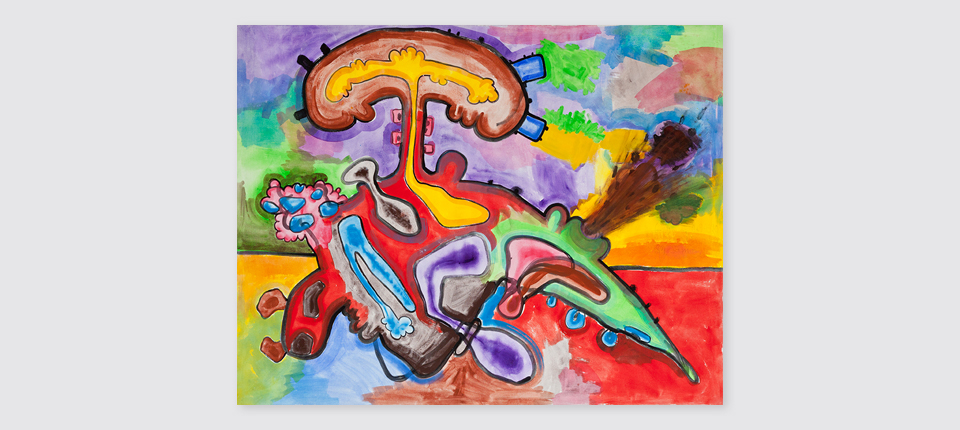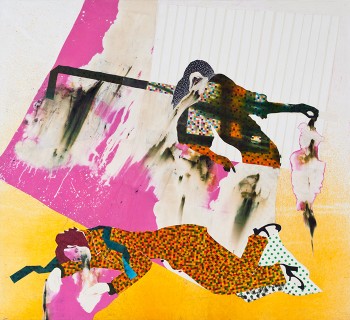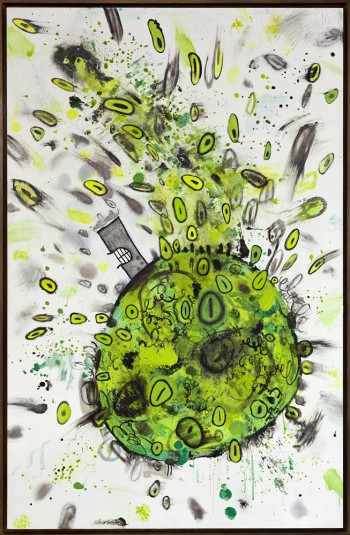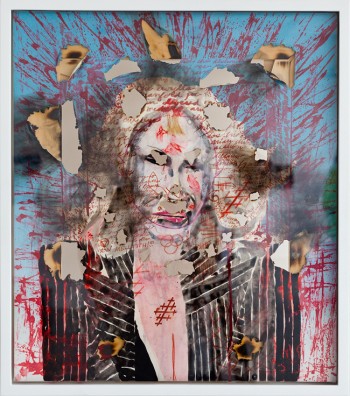Exhibition III
Without Hope Without Fear:Lara Schnitger, Tala Madani, Carroll Dunham, Reza Aramesh, Barnaby Furnas, Matthew Monahan, Whitney Steinway and Lothar Hempel
The title of Mottahedan Project’s inaugural show in Dubai derives from the Latin motto embraced by Michelangelo Caravaggio, nec spe nec metu, “without hope, without fear.” The seventeenth-century Baroque artist, whose successful yet tumultuous and violent life ended in an early and mysterious death, believed that a man without hope was a man without fear; in other words, to reach greatness, one must be willing to risk catastrophe. The exhibition includes artists from the US, Europe, and the Middle East: Lara Schnitger, Tala Madani, Carroll Dunham, Reza Aramesh, Barnaby Furnas, Matthew Monahan, Whitney Steinway and Lothar Hempel. Common threads throughout the works include gender and violence as well as explorations of painting as medium, topics frequently approached through humor.
Lara Schnitger’s works engage issues of gender and power within a dissolving landscape of painterly invention. Schnitger’s wall pieces contrast with the shocking yet comic nature of her sculptures, instead proving a more subtle challenge to the viewer’s preconceptions about beauty and gender. In their juxtaposition of materials and patterns, the works recall quilt-making as well as fashion, thus highlighting social tools across classes that are used to essentialize femininity. Her works dynamically fulfill gender roles as they deconstruct them, swinging between possibilities for a liberated and entrapped woman.
Tala Madani displays another type of subversion, inverting the objectification of the female body by depicting men with crude and lewd mannerisms. With a cartoonishness reminiscent of the work of Phillip Guston in its use of color and strong black lines, she ridicules abstraction’s effete narcissism as a purely self-referential exercise in a medium. Madani similarly rejects the exacting nature of an unambiguous linguistic, refusing to extensively employ English script or Persian calligraphy. Eschewing language’s claim to power—that is, hegemony in the case of English or the exoticization of Persian due to its vulnerability—she instead allows a freer hand in which symbols appear, reappear and disappear fluidly throughout her oeuvre. Yet, it is precisely her mastery that accounts for the liberality of her facture and what might even be called a blithe attitude in her work. Sardonic humor serves a way to collapse the distance between artist and viewer in Madani’s paintings and stop-motion animations. Time follows a spiral pattern rendering exact repetition impossible. Moreover, revisiting a space—i.e., the thinking space and the color space—can happen only in approximation. The spiral’s path can as easily serve as a downward slide as an upward track, challenging the capitalist idea of linear progress, and death alone can stop the cyclic swirl.
Continuing this thread, Carroll Dunham too combines issues of gender and sexuality with reflections on violence in his works. Depicting interior organs like in Floating Shape (1989-90), the works are somehow grotesque yet also, due to their bright color palettes, lighthearted and comical. The artist’s juxtaposition of conflicting elements recalls Surrealist painting. His paintings from the late nineties engage with the social on a grand scale: with circles populated by blind men and in the midst of explosions, they seem apocalyptic. The Second Green Planet (1996-97) figures as one such work, albeit with a sole character present at the doomsday depicted. Dunham’s style has been described as raw with emotional energy and, in its utilization of outlines so that the canvases resemble doodles that have then been colored in, even childlike; both characterizations seem apt for these two works. According to Dunham, his practice is driven by process rather than form; verging on automatist, the works grow organically.
Barnaby Furnas’ bloodied scenes are not apocalyptic but rather comment on time’s cyclicity and the recurrence of violence, collapsing history and the contemporary moment. Like in Dunham’s work, the characters are blind, and hence, unindividuated and anonymous. In Untitled (Effigy 1) (2006), Furnas expresses the visceral emotions of anger and fear in his depiction of a generic collector. The piece was made in response to the appearance of Furnas’ artwork at auction. His utilization of calf-skin vellum collapses the painting with its subject: the animal skin material stands for the human skin of the collector’s face, conflating the real and the image much in the same way as a political effigy. In burning the work, Furnas reasserts his ownership over the artwork; yet, by employing destruction to create a work that did in fact reach the market, he at once undermines and reasserts the value of the art object. The artist conveys not only a sense of self-deprecating humor, but also with the boasting confidence that affords it.
Reza Aramesh presents suffering as a shared experience and criticizes oppression broadly defined in his series, Action, featuring sculptures and large-scale photographs. Aramesh drew on recent images of war, including Vietnam, Korea and Iraq and employed nonprofessional actors to restage the scenes depicted. Like all the sculptures in the series, Action 125 was commissioned to an Italian studio and hewn from a single piece of lime wood. The resulting eerie realism of the figures references Renaissance art and church nativity scenes while the plinths display traditional geometric patterns of Islamic art. These works stand as a final and lasting reminder of the dichotomy between man’s fragility and the unflinching power of his will in the face of ceaseless inhumanity.
Like Aramesh, Matthew Monahan also reckons with classical sculpture but he does so by sidelining Western sculptural conventions in favor of moving even further back to ideas of the ‘prehistoric.’ With works that look like ongoing archaeological excavations but are in fact original objects composed largely of common Do-It-Yourself materials, Monahan plays with concepts of time and the weaving of creation and destruction. Buoy Boy (2011) is caught in the process of genesis; yet, the figure seems at once on the verge of freeing himself from and remaining at peace within the material that encases him. Rendering an origami-like folding of time typical of Monahan’s work, this sculpture signals birth and death simultaneously. In fact, it does so on a scale well beyond the individual life, spurring us to think of the history of humanity—contemplating civilizations that have or have yet to come.
Sharing an interest seen in the aforementioned works in the body as a site of fragmentation, power, and display, Whitney Steinway’s realistic paintings look to the rich history of figurative painting as a relevant model for an examination of legacy and death. Her depiction of suicide in Drowned Writer (2012) is at once beautiful and disturbing, and Green Street (2012), a reference to Alexander McQueen’s London home, examines the cult of the personality that might persist beyond such a tragic end.
Lothar Hempel’s works examine the relationship between the viewer and the object (or person) on display, calling forth a perpetual loop of visual and pleasure and suspicion. Unsettling the viewer, Plakat—Wie im Zoo! (2009) initially seems to expose power hierarchies and abuse but the appearance of a peacock feather as a weapon renders the image absurd and amusing. Like other works in the exhibition, the collage presents an ethical conflict, not only forcing us to analyze how we see—people, the past and artworks—but also inspiring reflection on how we live, and correspondingly, die.
Reza Aramesh was born in Iran in 1970 and graduated with an MA Fine Art from Goldsmiths College, London, in 1997. He continues to live and work in London. His recent solo exhibitions include Them who dwell on the Earth by Mottahedan Projects at One Marylebone in London (20111) and Between the Eye and the Object falls the Shadow at Gallery CMOOA in Rabat (2010).
Carroll Dunham, born in Connecticut in 1947, lives and works in New York. He earned a degree from Trinity College in Hartford, Connecticut, in 1972. Most recently, in 2010, Dunham exhibited his work in the following shows: Carroll Dunham: Paintings, Blum & Poe Gallery, Los Angeles; Carroll Dunham Prints: A Survey, University Art Gallery, State University of New York, Albany; Carroll Dunham: Paintings, Baldwin Gallery, Aspen, Colorado; The Visible Vagina, David Nolan, New York; Your History is not Our History, Haunch of Venison, New York; Selections from the Hammer Contemporary Collection, Hammer Museum, Los Angeles; and Pastorale, 80WSE, New York University, New York.
Barnaby Furnas was born in 1973 in Philadelphia, Pennsylvania. He received his BFA from the School of Visual Arts, New York, in 1995 and his MFA from Columbia in 2000. His most recent solo shows include If Wishes Were Fishes at Marianne Boesky Gallery in New York (2012); States of Glory at the Fort Worth Modern Art Museum (2012); and The Intimates at Stuart Shave/Modern Art in London (2011). Furnas lives and works in New York.
Lothar Hempel was born in 1966 in Cologne and currently lives and works in Berlin. He studied at the Kunstakademie Dusseldorf (1992). Hempel’s recent solo exhibitions include shows at La Conservera in Murcia, Spain, Anton Kern Gallery in New York, Stuart Shave Modern Art in London, Gerhardsen Gerner in Berlin, MGM in Oslo and Gio Marconi in Milan. He has also exhibited at Saatchi Gallery in London; Domaine Pommery in Reims, France; the Herzliya Biennial for Contemporary Art in Herzliya, Israel; and Centre d’Art Contemporain / Passage in Troyes, France.
Tala Madani, born in Iran in 1981, lives and works in Amsterdam and New York. After receiving her MFA from Yale University School of Art in 2006, she was awarded the Kees Verwey Fellowship and was artist in residence at the Rijksakademie van beeldende kunsten, Amsterdam in 2007. Recent exhibitions of her work include He Disappeared into Complete Silence, De Hallen, Haarlem (2011); Speech Matters, Venice Biennale (2011); and Greater New York, MoMA PS1 (2010).
Matthew Monahan was born in California in1972. His recent exhibitions include the following: Contemporary Arts Center, Cincinnati (2011); Statuesque, Nasher Sculpture Center, Dallas, TX; Anton Kern Gallery, New York (2010); Massimo de Carlo, Milan (2010); and Mineral Spirits: Anne Chu and Matthew Monahan, Institute of Contemporary Art, Philadelphia (2010). Monahan currently lives and works in Los Angeles.
Lara Schnitger was born in 1969 in the Netherlands. She lives and works in Los Angeles and Amsterdam. Her 2010 shows include those at Modern Art, London, the Sculpture Center, New York, and the Museum of Contemporary Art, Los Angeles; in 2009, she exhibited at Anton Kern Gallery, New York, and the Luckman Fine Arts Complex, Cal State, Los Angeles.
Whitney Steinway, born 1984 in Switzerland, studied Gender, Sexuality, and Women’s Studies at Virginia Commonwealth University and Fashion Design at the Otis College of Art and Design in Los Angeles. She continues to live and work in Los Angeles.









